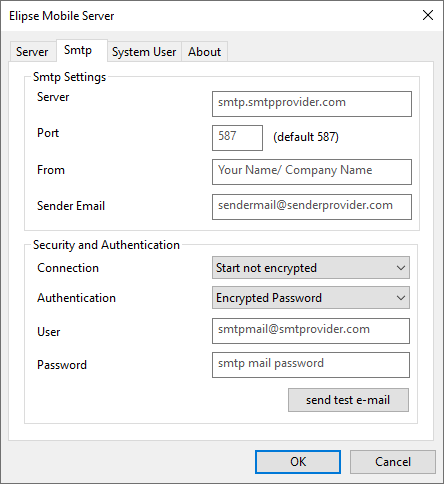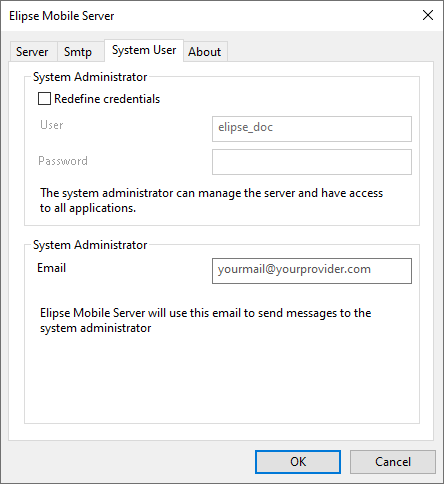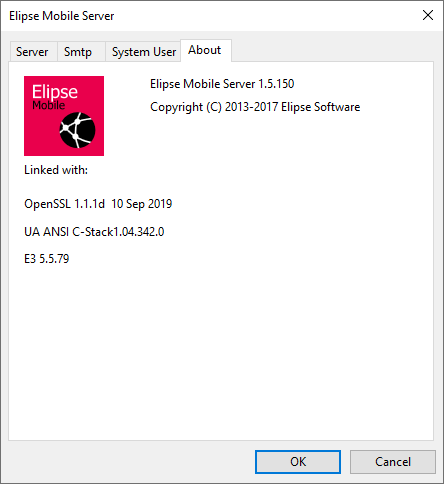To configure Elipse Mobile Server, right-click the Elipse Mobile Server ![]() icon on Windows Notification Area and select the Settings option.
icon on Windows Notification Area and select the Settings option.

Server tab
The available options on the Server tab are described on the next table.
Available options on the Server tab
Option |
Description |
|---|---|
Enable secure connections |
Enables a secure connection to the Server |
Security certificate (.crt) |
Indicates a connection's secure certificate file. Click Import to import a file with a .crt extension |
Private key (.key) |
Indicates a connection's private key file. Click Import to import a file with a .key extension |
HTTP |
Indicates the TCP/IP port used by an HTTP connection. The default TCP/IP port for HTTP connections is port 80 |
Indicates the TCP/IP port used by an HTTPS connection. The default TCP/IP port for HTTPS connections is port 443 |
NOTES |
•Please check topic Firewall Settings for more information about configuring TCP/IP ports. •To create a test certificate for HTTPS connections, please check article Generating a test certificate for HTTPS on Elipse Knowledgebase. •Please check article Available trusted root certificates for Apple operating systems for a list of pre-installed trusted root certificates on iOS operating system. |

Smtp tab
The available options on the Smtp tab are described on the next table. These options are used for sending e-mails to users and administrators, such as when users forget their passwords. These settings are used regardless of the client.
Available options on the Smtp tab
Option |
Description |
|---|---|
Server |
Address of an SMTP (Simple Mail Transfer Protocol) server |
Port |
TCP/IP port of a server. The default TCP/IP port for SMTP servers is port 587 |
From |
Name of an e-mail sender |
Sender email |
Address of an e-mail sender |
Connection |
Type of connection to a server. Possible values for this option are Start not encrypted (default), Encrypted (TLS), or Not encrypted |
Authentication |
Type of authentication. Possible values for this option are Using HMAC_MD5, No authentication, Normal Password, or Encrypted Password (default) |
User |
User name |
Password |
User password |
Send test e-mail |
Click to send a test e-mail using the configured options. This message is sent to the e-mail configured on the System User tab |

System User tab
The available options on the System User tab are described on the next table.
Available options on the System User tab
Option |
Description |
|---|---|
Redefine credentials |
Select this option to redefine the credentials of a system administrator user, defined in the User and Password options |
User |
User name of a system administrator |
Password |
Password of a system administrator |
E-mail address of a system administrator, used to receive important status information about a server |
The About tab shows information about Elipse Mobile Server version and all libraries used.

About tab
Server configurations are saved to a file called init.json, located on the installation folder of Elipse Mobile Server. This file contains configurations not available on the previously described tabs. The next table contains configurations that can be changed directly on this file.
Available options on the init.json file
Option |
Description |
|---|---|
admin_login_email |
Enables a system administrator to receive an e-mail whenever they perform a login. The default value of this option is false |
crossajax |
Enables Elipse Mobile Server to accept connections from another server. Possible values for this option are true or false (default) |
nthreads |
Indicates the size of the pool of threads of Elipse Mobile Server. The more simultaneous users, the larger the value of this option. The default value of this option is 24 and its minimum possible value is 8 (eight) |
securityversion |
Configures a minimum HTTPS protocol acceptable by Elipse Mobile Server. Possible values for this option are 0: Accepts SSL 2 and later, 1: Accepts SSL 3 and later, 2: Accepts TLS 1 and later (default), 3: Accepts TLS 1.1 and later, or 4: Accepts TLS 1.2 and later. It is recommended to always use the latest protocol version |
servername |
Name of a Telegram's reference server for sending messages |
URL of the Elipse Mobile Server's instance. This option is used in the external authentication by OpenID to identify which protocol to use, HTTP or HTTPS |
|
sysadmintelegram |
Indicates the identifier (id) of the system administrator's Telegram account. A way to discover an identifier is by using Telegram's web version. When opening the group's or user's chat to send a message, the corresponding identifier is shown alongside the address, such as https://web.telegram.org/a/#-4226494617 |
Indicates the token of a Telegram bot used to send messages, such as "bot6730154057:AAEQHPzbNJWqueMRM3xnDIjUHsBkQUUAAAA". For more information on how to create a bot on Telegram, check article How do I create a bot on Telegram's official documentation |
|
two_factor_authentication |
Requires a two-factor authentication from all users when a new device is registered. The limit of registered devices per user is 2 (two). When a new device is registered, the oldest device is removed. The default value of this option is false. Please check the next note and text for more information about this option |
hashfunc |
Defines a hash algorithm for user passwords. Possible values for this option are sha1 or pbkd. The PBKD (Password-Based Key Derivation) algorithm derives a key based on a password using a salt parameter and a number of iterations, as specified on RFC 2898 standard. NOTE: It is recommended to copy the entire Elipse Mobile folder before converting to PBKD format. This copy can then be used to open an Application in a version previous to version 1.7.38. |
NOTE |
A two-factor authentication is not required from users created with a unique device and system administrators. |
Two-Factor Authentication
Whenever a user logs in a device not yet registered in Elipse Mobile Server, an e-mail is sent to this user with a code. That code must be provided on the login screen to finish the registration of this device. The maximum expiration time for this code is 1 (one) minute. The maximum number of devices registered in Elipse Mobile Server is 2 (two). Whenever a new device is registered, the oldest registered device is removed. When a user executes a login on a device already registered, the two-factor authentication is not required, only when that user executes a logout. System administrator users are advised to configure the admin_login_email option to true to receive an e-mail whenever they execute a login.